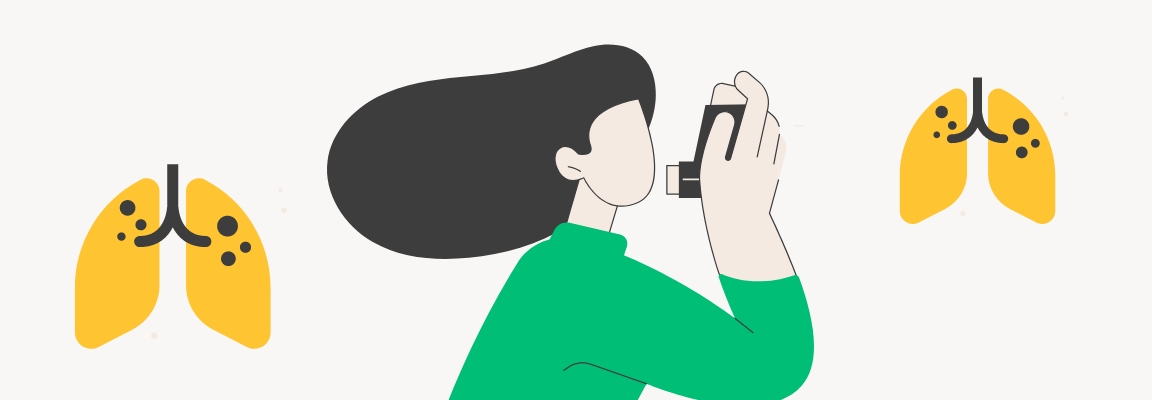We may not all know someone with asthma, but we certainly know someone who claims to have it, with no other proof than coughing at that moment. The classic asthma cough.
The suspicion is natural. What is asthma? Asthma is a very common disease. In 2019, it was estimated that there were 262 million people affected and 455,000 deaths due to it.
In the United States, in 2021, 6.5% of children and 8% of adults had this disease. That’s almost one in twelve people.
All this makes asthma one of the most prevalent non-communicable diseases and the most common chronic disease in children.
And asthma is chronic. Specifically, it is a chronic pathology of the lungs that causes inflammation and muscle stiffness in the airways, making breathing and lung function difficult.
This generates asthma symptoms that are easy to detect. The most obvious symptom is coughing, which can be either dry or productive. There are also wheezing sounds during breathing, chest pain (which can be accompanied by tightness), an altered breathing rhythm, and, of course, breathing difficulties (problems inhaling and exhaling air).
Coughing and Other Subtle Symptoms
Although asthma may not initially appear to be a severe disease, especially with proper treatment, sometimes the inability to supply the necessary oxygen to the body can reach very alarming levels.
In these cases, we have new symptoms: cyanosis (a bluish tone to the skin), pulse acceleration, inability to speak, and decreased consciousness. It is a disease that can lead to death.
Asthma is chronic, and therefore the person always has the disease, but the times when the symptoms worsen are what we call an asthma attack or asthma crisis. In these episodes, the inflammation and narrowing of the airways reach their peak.
An asthma attack can last from minutes to days, and can start suddenly or develop over several hours.
The most common causes are the inhalation of substances (often allergens) that trigger that reaction by the body. Here, because each person is unique, we have a considerably long list of culprits: dust mites, mold, pollen, tobacco, dust, animal dander…
Other causes may not be inhalants. Physical activity, some medications, climatic or emotional changes (such as stress) are responsible in some individuals.
Some compounds do not cause the disease, but worsen it in certain people. This is the case, for example, with salicylic acid and other NSAIDs (non-steroidal anti-inflammatory drugs), to which some people are intolerant. In these situations, a worsening of asthma and its symptoms occurs within a few hours, requiring action.
Do you know another factor that plays a role in asthma? Of course, you do. We always talk about it here. Genetics.

Is Asthma Genetic?
Although for our regular readers this will seem like déjà vu, asthma is a pathology caused not only by environmental factors but also by genetic ones.
Following that déjà vu, the combination of both types of factors is complex and leaves gaps in understanding.
When a person develops asthma after the age of 12, it is usually due to environmental factors, while in children 12 or younger, genetic causes are the primary culprits.
As with other complex diseases where genetics play a role, having a family history of relatives with asthma is considered a risk factor. Having family members with allergies can sometimes be a risk factor for developing asthma. Third and last déjà vu: you don’t inherit asthma, but you do inherit the risk of developing it.
By 2005, there were already 25 genes that had been linked to asthma in at least six different populations. Most of these genes were involved in regulating inflammation or immune system activity.
One of the challenges in expanding the list of involved genes is the lack of consistency across populations. The same gene may or may not be involved in asthma, depending on the individual.
This is partly because some genetic variations depend on specific external factors to develop the pathology (what we’ve mentioned about complex diseases having both genetic and environmental factors), factors to which not all individuals are exposed. An example is a variant of the CD14 gene that causes asthma when the individual is exposed to endotoxins. Moreover, it is considered that one of the reasons for the increase in asthma in the population (yes, we are dealing with one of those diseases that gain prevalence with each passing year) is due to epigenetic changes.
Asthma Treatment Pharmacology
When you’re as common a disease as asthma, people decide to dedicate a lot of time to finding ways to combat you, which is why the list of treatments (because curing it is currently impossible) for asthma is even longer than the list of its causes.
They can be classified into:
- Long-term maintenance or control. These are used consistently, even when the patient feels well, in individuals with moderate to severe asthma. The goal is to control and prevent symptoms.
- Quick relief or rescue. These are used at specific times, such as during an asthma attack or when there are breathing difficulties.
- Those that don’t fit into the other two groups. Okay, this group isn’t actually called that; we made up the name. This category would include medications for asthma caused by allergies and other exceptionally used treatments.
Many of these medications are administered by inhalation, with asthma inhalers. For instance, inhaled corticosteroids are the main long-term control medication used for asthma. They reduce both inflammation and the narrowing of the airways.
Others are taken orally. For example, Montelukast, also a long-term control medication, is a leukotriene modifier. Interestingly, by blocking leukotrienes, a molecule produced by leukocytes, they prevent and treat asthma symptoms, but are NOT effective during an asthma crisis.
Quick-relief medications are generally short-acting beta agonists. These are bronchodilators, administered by inhalation (makes sense, you want them acting instantly) that relax the muscles in the airways. Their use is recommended only when necessary, as these drugs have more severe side effects, and we don’t want to treat some symptoms only to introduce others. Fortunately, the Advanced kit from tellmeGen is compatible with asthma. And without side effects.



